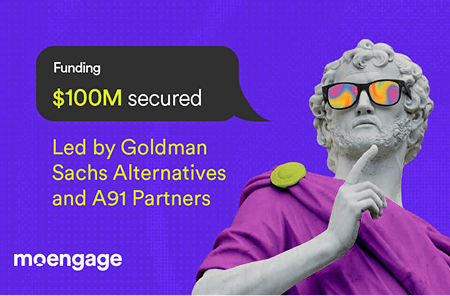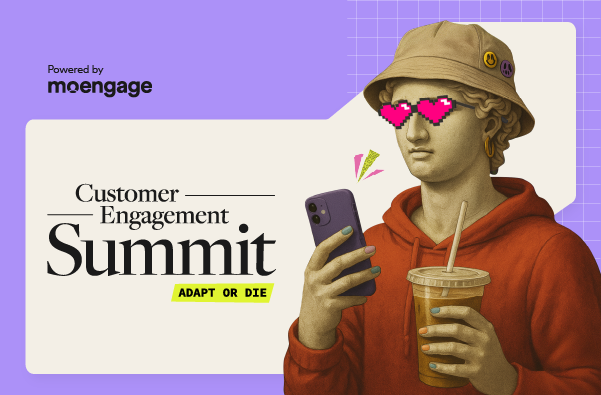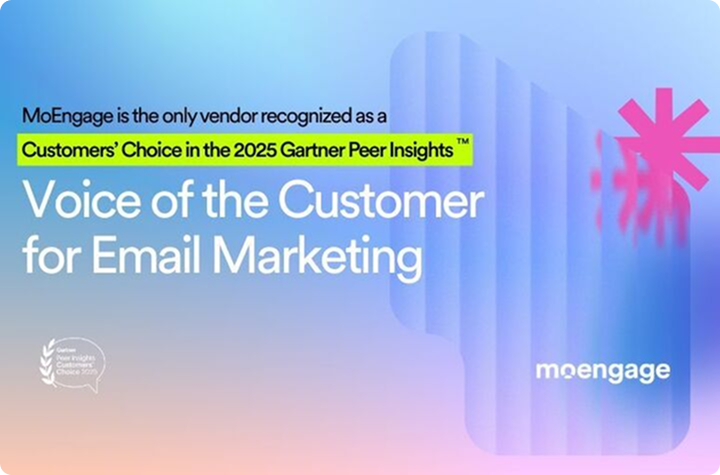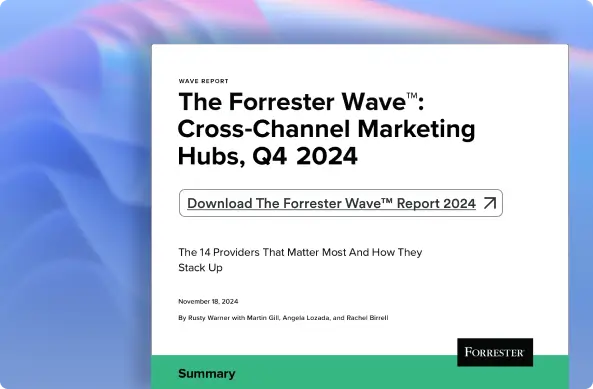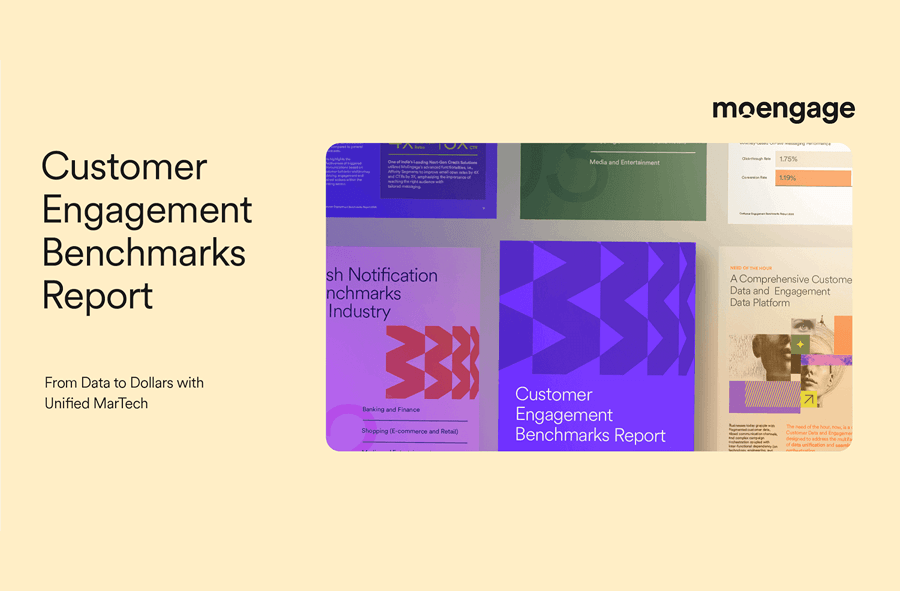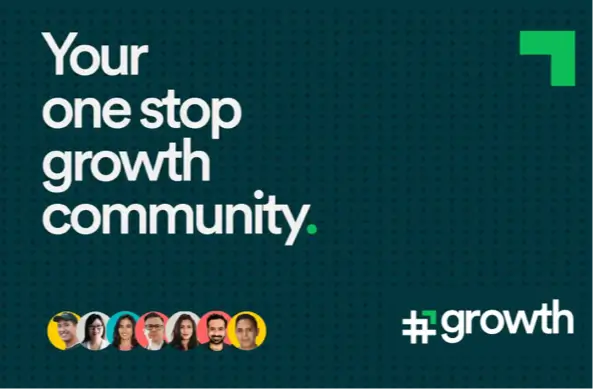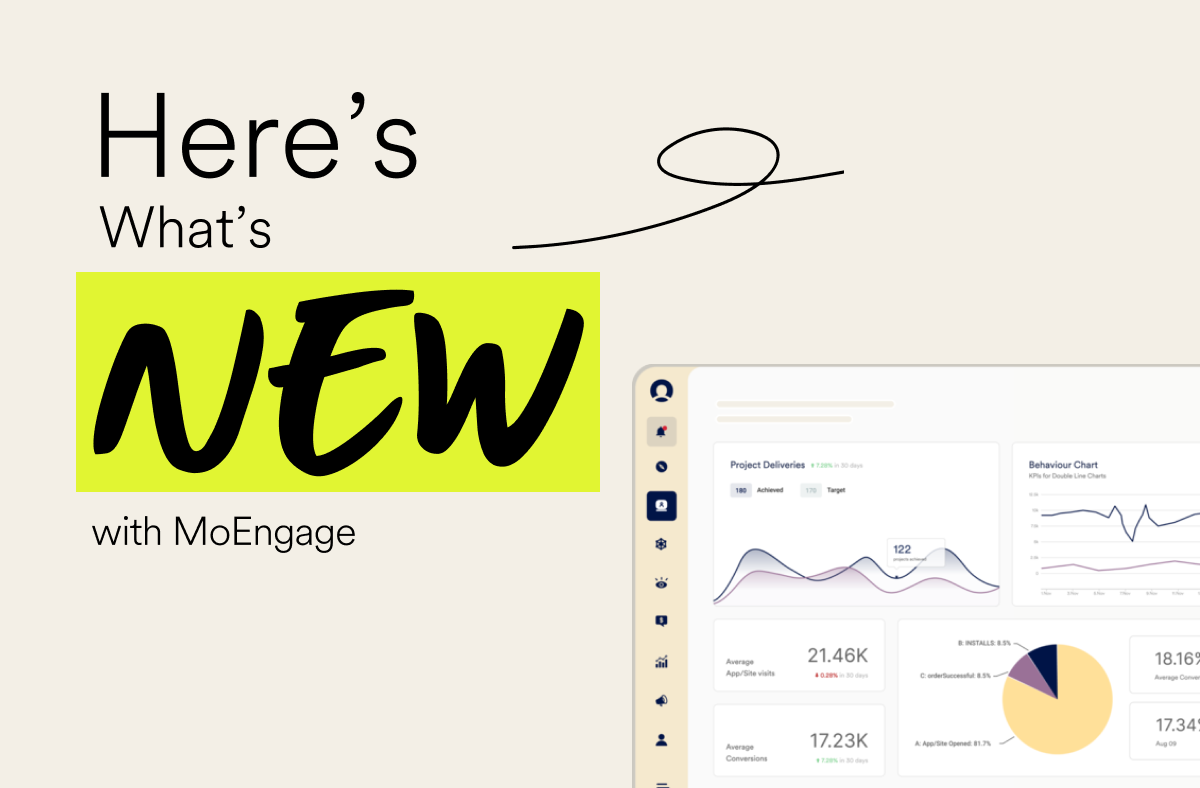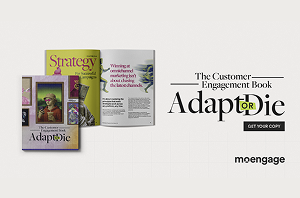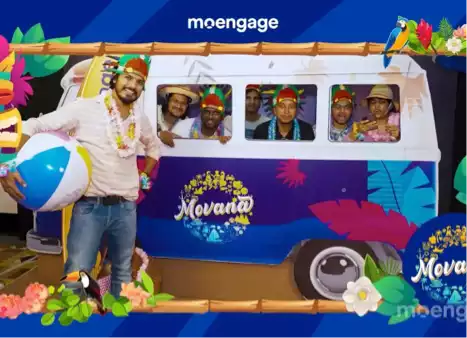How Does Customer Journey Automation Work?
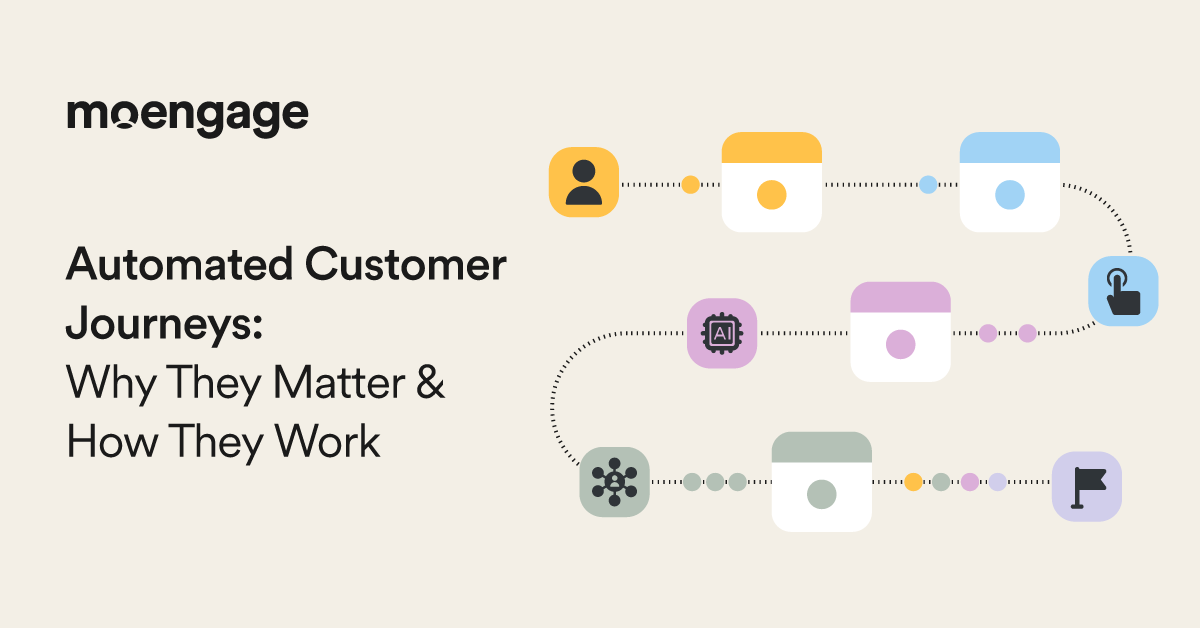
Reading Time: 12 minutes
Too many marketers treat customer journey automation like an overhyped campaign scheduler. They think it’s just about sending the right offer at the right time.
But that’s an oversimplification.
It’s actually much more than that. Savvy marketers are using automation to design adaptive experiences that advance customers from awareness to loyalty, while removing friction at every stage of the customer purchase journey.
In this blog post, we’ll break down everything about automating customer journeys, including the methods, the tools, and the optimizations that help your brand grow. So stick around till the end.
What is Customer Journey Automation?
Customer journey automation is the process of using technology to automatically guide every customer through a series of personalized and timely interactions, from initial contact to loyal advocacy, without manual intervention. By reducing friction in the journey, it helps drive loyalty and control churn.
Automating customer journeys enables the delivery of a connected, adaptive flow that responds in real-time to customer behavior. It ensures that every touchpoint aligns with a customer’s stage, intent, and channel preference, creating a seamless customer experience.
3 Core Benefits of Customer Journey Automation
Before you can invest in customer journey automation, getting stakeholder buy-in is key. But how?
One way to do that is to highlight the benefits of automating journeys. By using automation to guide customers from their first touchpoint to becoming a loyal advocate of your brand, you reduce wasted effort. More importantly, you can create experiences that customers actually want to return to.
With that in mind, here are three advantages of automating customer journeys that you can point out to your leadership.
1. Lower operational costs
Without customer journey marketing automation, your team spends hours manually tracking campaign results. You no longer need to involve humans in different customer touchpoints. Because of that, you can redirect the manpower to other, more pressing needs, like strategy.
Over time, those labor savings add up to lower operational costs. For instance, Gartner found that brands implementing hyperautomation in process redesign see up to 30% less operational expenses.
2. More efficient marketing
Customer journey automation aligns every touchpoint with where the customer is right now. It also ensures that the touchpoint connects seamlessly to the next step in the customer journey.
As you waste less bucks on irrelevant impressions, your conversion rates improve. For example, say you’ve timed an offer only when a customer moves from the consideration stage to the purchase stage. You’ll be spending less money chasing shoppers who aren’t ready to buy your product. Your budget will be focused on those who are actually going to convert.
3. Enhanced customer satisfaction
Automation can significantly enhance the customer experience at every point of interaction in their journeys. If their experience improves, so do their satisfaction levels.
According to Gitnux’s 2025 Workflow Automation Statistics Report, 85% of organizations believe automation helps meet customer expectations more effectively. So much so that customer complaints have reduced by 25% in sectors that use automation.
Apart from bringing these advantages to light, there’s another way to get approval from your leadership.
Angela Rueda, Director of Business Marketing Technology at Meta, shares in the Customer Engagement Book Interview how powerful it is to make the customer journey visible. When pitching new technology or a marketing strategy to stakeholders, she maps out each stage of the customer experience. Then, she shows how the technology powers the channel, personalization, or data input throughout the journey.
This approach helps stakeholders understand both the customer impact and how technology enables it, leading to stronger buy-in for investing in additional tools or automation.
Now that you (and your stakeholders) know why automated customer journeys matter, it’s time to learn how they actually work.
How Does Customer Journey Automation Work?
At its core, customer journey automation is about delivering the right message to the right customer at the right time. But to make it work for your brand’s campaigns, you need to understand how it works.
Let’s examine the key components of the automation process for customer journeys.
1. Map out customer journeys with precision
Before automating any customer journey, take a step back and think: how do you even know what to automate? As in, how can you understand your customers’ interests, needs, behavioral patterns, and pain points? It’s a three-word answer: customer journey mapping.
Mapping out a customer journey means monitoring customers as they move through the different stages of their journey, from awareness and consideration to decision and retention. Otherwise, you’ll be in the dark about the kind of automation you need to do for optimizing each journey stage.
As Martech expert Scott Brinker says, “Mapping [the journey] out, even if it’s a decision tree, is still useful to understand.”
According to Scott, consumers come through various mechanisms or with different intents. In his Q&A for his chapter of The Customer Engagement Book, he asks marketers to consider what a customer’s process or pain points might be when determining whether or not to make a product or service purchase.
This is a key step to understanding the many paths a consumer may take before becoming a customer.
Once you’ve created a customer journey map, list all the touchpoints or channels where your customers interact with your brand. These include your website, social media, emails, and customer support tickets. Visualizing all the stages and channels involved in the customer journey in the form of a map makes delivering an end-to-end customer experience easier.
2. Establish behavioral triggers
An automated customer journey is incomplete without behavioral triggers: specific customer behaviors or actions that trigger a series of automated events. For example, when a customer abandons their shopping cart, subscribes to your newsletter, or buys a product from your website, an email sequence could be triggered.
Along with clearly establishing triggers, you should set up tailored messages based on your customers’ past interactions and behavior. If they’ve bought a product, for instance, you can trigger an automated email campaign, sharing smart product recommendations related to the product they’ve purchased.
3. Personalize every customer interaction
Gone are the days when any brand could adjust the customer’s name in their greetings and call it ‘personalization’. Today, personalization is the heart of an effective marketing automation customer journey. That means you need to adjust the messaging, offers, and timing based on each customer’s purchase or browsing history and preferences. Sending out generic messages is out of the question.
Why, though? Because customers expect brands to know and understand their journeys. The more they feel understood and valued, the more likely they are to engage and convert.
To personalize the customer experience effectively, segment audiences based on their journey stage and engagement level. Then, deliver hyper-relevant content depending on their purchase history, browsing behavior, and preferences. Your tone and style should resonate with each segment (such as new vs. VIP customers).
4. Ensure coordinated messaging across channels
Your customers are likely to interact with your brand across multiple channels, not just one. From email and your website to your physical store, they keep moving among touchpoints. Bearing that in mind, coordinated messaging means ensuring that every customer interaction feels consistent, no matter where they interact.
Enter omnichannel customer experiences. If your marketing isn’t omnichannel, or if your messaging isn’t consistent, your customers will be left scratching their heads.
Let’s say you’ve sent them a friendly push notification with a 10% discount offer. But your serious email campaign mentions nothing of the sort. Because the message, tone, and voice in both channels are different, your customers get confused.
So what’s the workaround here? While automating customer journeys, create channel-specific versions of the same core message. Maintain the same tone, brand voice, and visual style. Sync campaigns so that each channel can update based on a customer’s action elsewhere.
It’s best to use a customer engagement platform (CEP), a CRM, or a customer data platform (CDP) to keep all interaction data in one place.
5. Test and optimize the customer journey automation process
How can you keep improving the customer experience and your conversion rates over time? The best way to do that is to constantly test and refine every element of your customer journey automation.
A/B test different content formats, subject lines, and message timing. Once the customer journeys are automated, monitor conversion and customer engagement metrics at each journey stage.
These steps, along with continuous testing, can help you identify what’s working and what’s not at specific stages of the automated customer journey. You need to keep refining your journeys to make them efficient and impactful.
How to Automate the Customer Journey and Increase Efficiency
So far, you’ve uncovered what customer journey automation is and how it works. Now is the time to get your hands dirty with the actual automation process. You just need to turn what you already know about your customers into a set of data-driven and targeted actions.
Here’s how to do that using modern marketing automation software.
1. Auto-segment audiences
Manually sifting through demographics and customer lists to segment audiences for a personalized customer journey? Please, we aren’t in the early 2000s anymore.
Segmentation is the foundation of any personalized journey. Dynamic segmentation uses customer data, including behavior, preferences, and purchase history, to ensure each customer gets messages and offers that are relevant to them today, not two months ago.
So, when your segments update in real-time, your campaigns still send the right messages to the right customers. That’s right, no more sending welcome emails to customers who have already bought from your brand thrice.
How to do it
Identify your key audience attributes and set automation rules or AI logic that refresh segments in real-time, in response to changes in these attributes. This way, your messaging is always in tune with where your customers are in their lifecycle.
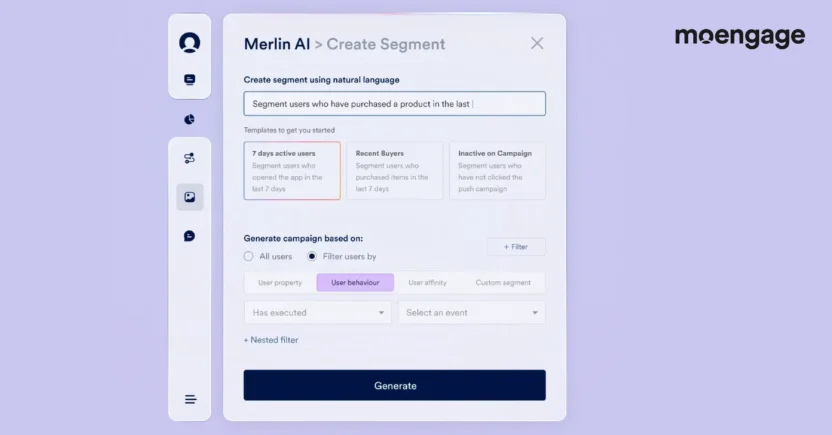
MoEngage’s Merlin AI Segment Assist, for example, automatically segments customers based on purchase history, preferences, behavior, and engagement patterns. All it needs from you are simple, natural language prompts.
To enable the AI engine to understand how your customer data is labeled, the feature includes AI-generated event and user attribute descriptions, which add metadata to your attributes and events.
2. Build multi-step customer journeys that adjust in real-time
Do you know when automated customer journeys work best? When your brand listens to what a customer does or doesn’t do, and responds with the right next step.
As we mentioned earlier, mapping out journeys means identifying your customer customers’ lifecycle stages first. That’s followed by setting conditions and triggers for movement between the stages. Basically, the journey should adapt as customer behavior changes.
How to do it
- Define the key outcomes you want to achieve at each stage.
- Next, map the triggers that move customers forward in their journeys, or re-engage them if and when they stall.
- Visualize the journey to see the path a customer might actually take.
For instance, MoEngage Flows helps you visually map the entire customer journey, step by step.
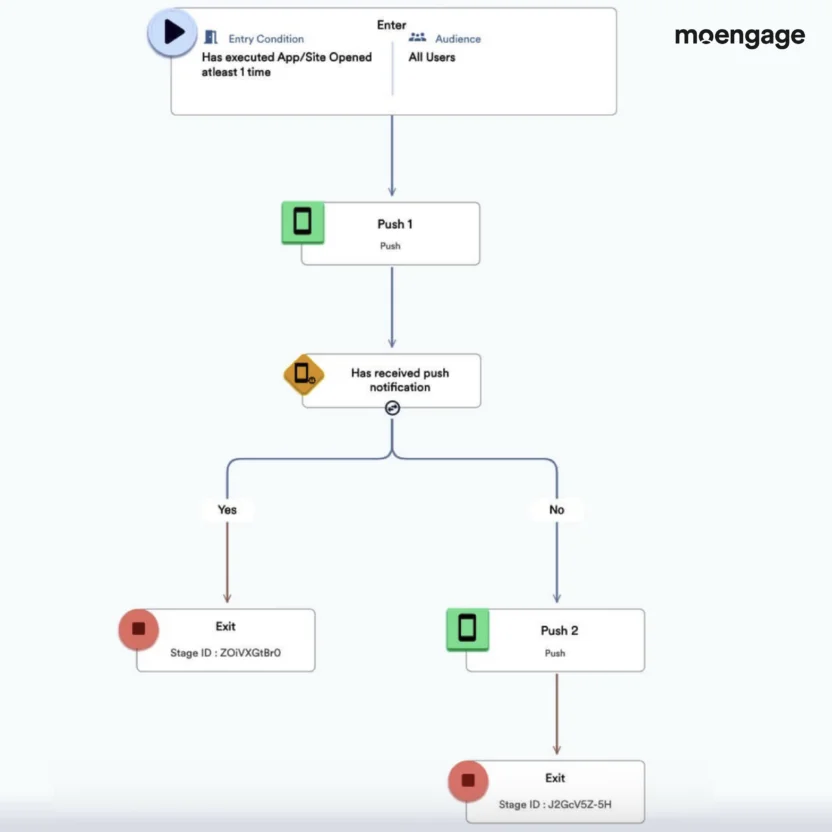
This is impactful because every customer interaction builds on the last interaction, which in turn, builds on the one before. That’s why it appears as a connected story, rather than a disconnected string of messages.
Start with either ready-made templates (for onboarding, abandoned cart recovery, engagement, or reactivation) or a blank canvas.
Then, visually map the customer journey, segment audiences, define entry conditions, and set conversion goals that guide the flow’s structure.
3. Keep testing and optimizing journey paths
Even a well-designed journey is bound to lose its edge over time. To keep them fresh, you need to test and optimize them regularly. That’s how you can identify which channels, messages, and sequences get the best results and adapt instantly.
Essentially, you can run variations of a journey path. Then, use automation to direct traffic toward the path that is performing best, without needing to manually redirect customers to the best-performing path later.
How to do it
- Build variations, such as different offers and email subject lines, into your journey branches.
- Let your customer journey automation platform monitor key metrics, like conversions and engagement rates.
- As soon as the data points to the best-performing path, automatically route more customers toward that path.
You can use MoEngage’s Intelligent Path Optimizer (IPO) to automatically reroute customers toward paths that are delivering higher conversions or better engagement.
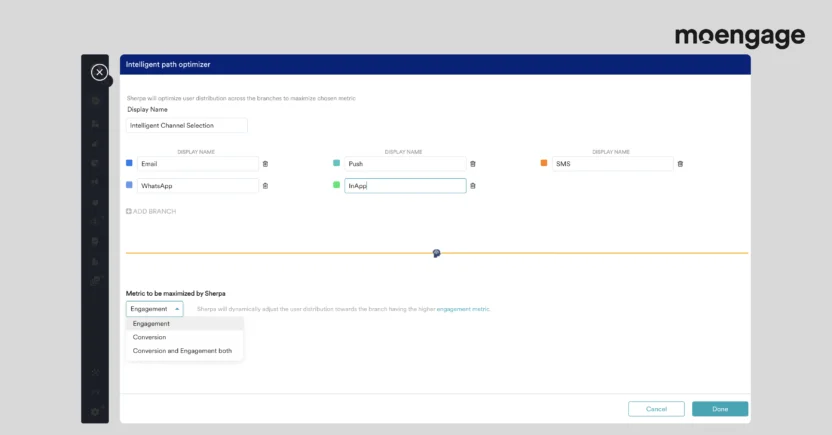
IPO A/B tests up to 5 branches before optimizing the user distribution. Instead of pushing every customer through the same rigid steps, you adapt dynamically in real-time.
While designing a flow in the journey builder, you can add an IPO at any point in the journey where you need to experiment with multiple branches of the journey. The tool will monitor results and adjust user distribution based on which route performs better, letting more customers see your highest-converting or most engaging content.
4. Personalize the next step for every customer
At a deeper level, the goal of personalization is to predict the next best action for every customer right now, based on their history with your brand and their recent intent signals. For example, for a customer who browses your sale page without making a purchase, the next step could be a limited-time offer sent via email.
The upshot of this approach is that every interaction aligns with customer intent. In turn, customers feel like your brand gets them.
How to do it
- Track customer activity across your channels.
- Set AI models or rules to predict the most relevant next channel and message.
- Add fallback options so that there’s always an engaging next touchpoint, regardless of whether the data is complete.
Based on their past behavioral patterns and likelihood to engage, MoEngage’s Next Best Action (NBA) predicts on which channel each customer should see or receive messages next, and when.
Let’s say a customer enters the NBA stage of your Ecommerce customer journey. MoEngage’s AI then selects the customer’s most preferred channel and the optimal hour, based on their activity data over the past 60 days.
Add NBA as a stage in MoEngage Flows while building omnichannel customer journeys. Select a fallback channel in case the most preferred channel is unavailable for a customer.
5. Auto-schedule messages
Building on the previous point, if you don’t optimize message timing, you may be sending messages when customers are busy and unlikely to respond.
Why does it matter? Timely delivery keeps customers moving forward in their journey. You don’t want them to ignore your message or abandon their journey entirely just because your message reached them at the wrong time.
So, instead of blasting everyone at a fixed time, analyze historical data for each customer, such as open rates and click patterns. You can then automate the sends around their unique engagement window.
How to do it
- Track engagement time for every touchpoint
- Identify patterns for each customer or segment
- Automate delivery schedules to consistently hit that customer’s engagement window
MoEngage’s Best Time to Send (BTS) uses machine learning to ensure each touchpoint reaches a customer when they’re most engaged with your brand.
For each journey stage, enable BTS on touchpoints. That way, the campaign delivery will be based on the individual customer’s engagement pattern. This maintains the natural pace of the customer journey.
3 Best Customer Journey Automation Platforms
The right customer journey automation platform will let you visualize journeys, set up triggers, personalize at scale, and keep all messages coordinated. It’s all supposed to be easy.
Below, we’ve rounded up three software platforms that can help you deliver a frictionless experience at the end of the day.
1. MoEngage
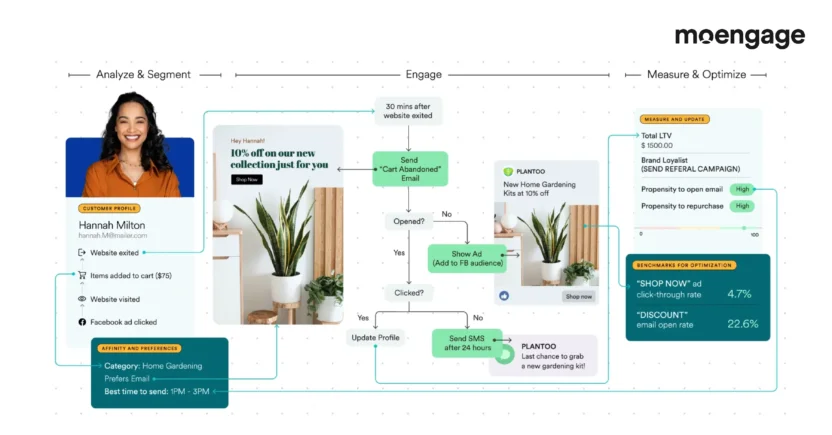
MoEngage is an AI-powered real-time customer engagement platform. It’s designed to help brands create seamless, data-driven customer journeys across 10+ channels. The platform stands out for its strong analytics capabilities and AI-based recommendations. Which means you can act on solid, real-time insights, no guesswork involved.
Best for: B2C marketers from retail, Ecommerce, fintech, QSR, and media and entertainment brands, who need to manage complex, omnichannel customer journeys at scale.
Key automation features: MoEngage Flows lets you visually design omnichannel customer journeys and set behavioral triggers using its drag-and-drop journey builder. You can also run A/B split and conditional split tests on the journeys. Its AI engine can even suggest the best time to send an email or any message to maximize engagement. Additionally, MoEngage offers a Multiple Conversion Goals feature that tracks the intermediate steps taken by a customer on the way toward their primary conversion goal. Its Revenue tracking feature shows you the monetary impact of your campaigns in the customer journey.
Explore more of MoEngage’s features that help to automate customer journeys.
2. Lucidchart
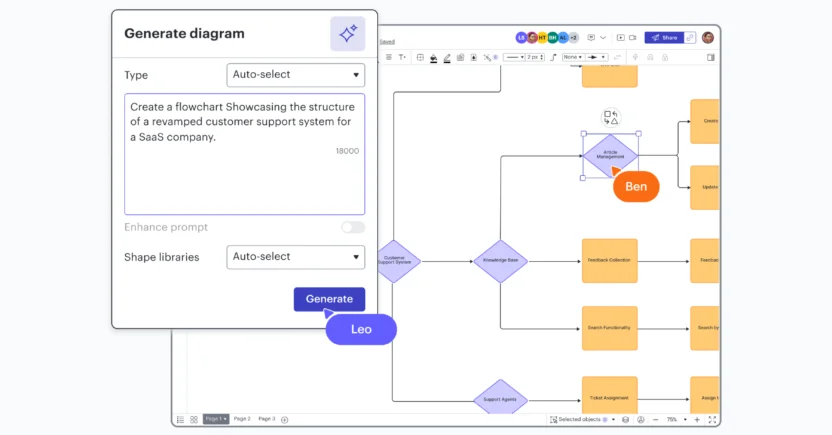
Although not a traditional customer journey automation solution, Lucidchart is essentially an AI-driven diagramming tool for clearly mapping out customer journeys. The tool’s intuitive drag-and-drop interface allows you to collaborate with your team members in real time. It even provides a pre-built customer journey map template you can tweak.
But since it’s more about planning than executing, you’ll still need to plug Lucidchart’s journey maps into an actual marketing automation platform to make them work.
Best for: Marketing teams that need to map and visualize their customer journeys in detail before handing them off to an automation solution.
Key automation features: With Lucid AI, you can automatically generate structured customer journey maps using complex or vague AI prompts. Use conditional formatting rules to make your journeys more detailed. And if you want a text-based summary of the journey, Lucidchart is at your service.
3. Sprinklr
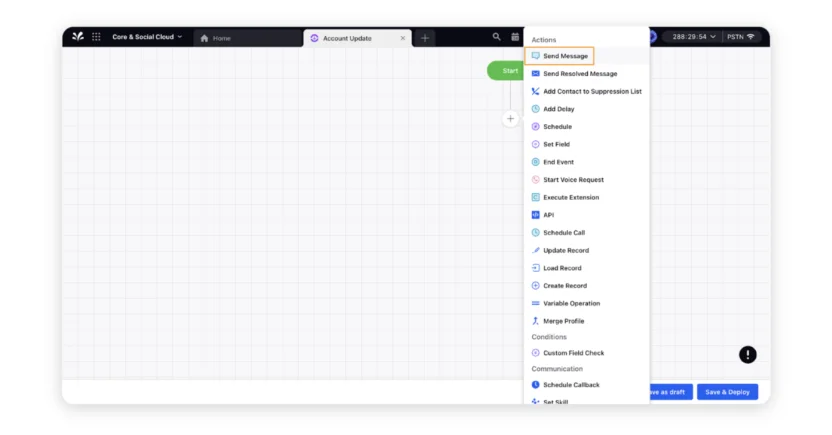
A powerful unified customer experience management (CXM) platform, Sprinklr covers marketing, advertising, social engagement, and customer service in one place. As it can tie together data from multiple channels, it gives you a comprehensive view of the customer relationship.
The catch is, Sprinklr is fairly difficult to set up and integrate, especially for new users.
Best for: Enterprise-level marketing and CX teams
Key automation features: Sprinklr’s Journey Facilitator lets you use a visual builder to create unified, omnichannel customer journeys. You can import leads to target audiences and even analyze the journey’s performance. Sprinklr AI also analyzes conversation history and customer intent to personalize all interactions and automate key workflows.
Executing Flawless Customer Journey Automation: Closing Thoughts
As you can see, automated customer journeys make your marketing efforts more efficient and deliver memorable customer experiences every step of the way. The notable payoffs are better customer relationships and your brand’s growth.
But to bring these events about, you need a powerful customer journey automation platform like MoEngage. To see a flawless journey in action, book a MoEngage demo today.

